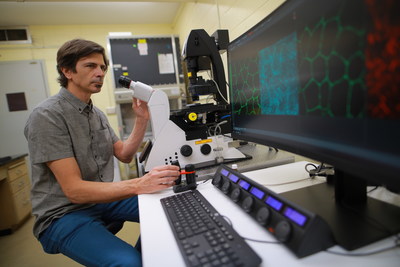
BUFFALO GROVE, Ill., May 6, 2021 /PRNewswire/ — Leica Microsystems Inc., a developer and manufacturer of microscopes and scientific instruments for the analysis of microstructures and nanostructures, has announced that Dr. Rafael Garcia-Mata’s lab, Department of Biological Sciences, University of Toledo, is the recipient of the 2020 STELLARIS Award. Researchers from laboratories across the United States were eligible to apply for the award, in which one lab would receive a new STELLARIS confocal microscopy system.
Each applicant provided details of their research, discussed any limitations with their current imaging systems and how those constraints have affected their experiments, and explained how their research could benefit from new cutting-edge imaging capabilities. Hundreds of worthy applications were received from researchers running the gamut of life science fields. An independent panel of judges narrowed the pool of eligible labs to a single recipient among the depth and breadth of qualified applications. Dr. Garcia-Mata’s lab and the research conducted there was selected as the most deserving of a new STELLARIS system based on various scoring criteria.
Dr. Garcia-Mata’s laboratory focuses in elucidating the mechanisms that regulate Rho GTPases and their signaling partners in order to gain new insights about the cellular processes controlled by the Rho family of proteins, including the organization of the cytoskeleton, cell migration, adhesion, and polarity. These processes play key roles in the regulation of normal cells and tissues, as well as during a wide range of diseases including cancer.
STELLARIS, the new confocal platform from Leica Microsystems, provides researchers the power to collect more accurate and reliable data to prove hypotheses with precision. The combination of Power HyD detectors, White Light Laser, and sophisticated software delivers brighter signals, resulting in images with more contrast and astounding detail compared to previous imaging modalities. Scientists are finding that the unique TauSense lifetime-based imaging modes open up the potential to discover more as well. These modes complement a multitude of new ways to explore the function of molecules in their cellular context and help, for example, separate fluorophores even when their emissions fully overlap.
“We are thrilled by the prospect of how the STELLARIS platform will help advance our research,” says Dr. Garcia-Mata, Associate Professor, University of Toledo. “We plan to use STELLARIS to study the dynamics of small and transient structures like nascent adhesions and secretory vesicles, which are dim, short lived, and harder to distinguish from the background. We expect this system to transform our studies on mechanotransduction and contractility in both migrating cells and epithelial cell layers. And we plan to use lifetime analysis in live cells using tension/contractility sensors to follow cell-cell adhesion, migration, organogenesis and cell polarity.”
“This has been a remarkable process,” says Greg Eppink, General Manager Microscopy, Leica Microsystems Americas. “This unique program was enthusiastically received by the community of life science researchers we support with our imaging solutions. We look forward to partnering with Dr. Garcia-Mata to fully explore the novel innovations of the STELLARIS platform to overcome the imaging challenges specific to his science.”
About Leica Microsystems
Leica Microsystems develops and manufactures microscopes and scientific instruments for the analysis of microstructures and nanostructures. Widely recognized for optical precision and innovative technology, the company is one of the market leaders in compound and stereo microscopy, digital microscopy, confocal laser scanning and super-resolution microscopy with related imaging systems, electron microscopy sample preparation, and surgical microscopy.
Leica Microsystems has six major plants and product development sites located in Wetzlar and Mannheim (Germany), Vienna (Austria), Heerbrugg (Switzerland), Morrisville (USA), and Singapore. The company is represented in over 100 countries, has sales and service organizations in 20 countries, and an international network of distribution partners. Its headquarters are located in Wetzlar, Germany. Leica Microsystems is part of Danaher.
![]() View original content to download multimedia:http://www.prnewswire.com/news-releases/2020-stellaris-award-recipient-announced-301285328.html
View original content to download multimedia:http://www.prnewswire.com/news-releases/2020-stellaris-award-recipient-announced-301285328.html
SOURCE Leica Microsystems


























